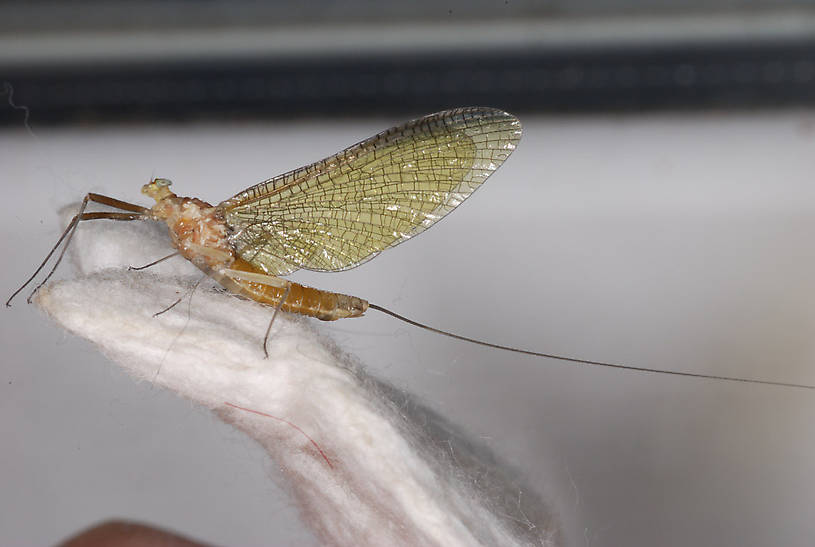
Hex Mayflies
Hexagenia limbata
The famous nocturnal Hex hatch of the Midwest (and a few other lucky locations) stirs to the surface mythically large brown trout that only touch streamers for the rest of the year.


Mayfly Species Ironodes nitidus (Slate Maroon Drakes)
This large dark mayfly is one of the most unusually colored insects to hatch on Western streams, for its sternites are a reddish maroon.
Where & when
This species is most widespread across the West, but it receives the most praise for hatches in the Pacific Coast states.In 9 records from GBIF, adults of this species have been collected during June (67%), May (22%), and July (11%).
Species Range
Hatching behavior
The emergence does not last very long, but it can be intense. These mayflies escape their nymphal shucks underwater, usually while clinging to the bottom except in unusually slow water.Swisher and Richards in Selective Trout recommend fishing a nymph deep throughout this hatch.
Spinner behavior
The spinner falls are unimportant.Nymph biology
Current speed: Fast
Substrate: Gravel and rocks
Physical description
Most physical descriptions on Troutnut are direct or slightly edited quotes from the original scientific sources describing or updating the species, although there may be errors in copying them to this website. Such descriptions aren't always definitive, because species often turn out to be more variable than the original describers observed. In some cases, only a single specimen was described! However, they are useful starting points.
Male Spinner
Wing length: 11-14 mm
A large yellowish brown species, slightly paler than the allied Ironodes californicus.
Frontal margin of head yellowish brown, reddish brown elsewhere; a distinct reddish spot on vertex between eyes, sometimes with reddish shading also around bases of antennae and ocelli. Thorax light yellowish brown. Pronotum extensively shaded with smoky brown. Mesonotum not much darker than pleura; depressions on each side of scutellum dark brown. Many specimens have a creamy area anterior to base of fore wing, containing two red streaks; creamy streaks may be present also on pleura, below wing roots. Reddish areas on pleura above base of fore wing, above base of fore coxa, and anterior to bases of middle and hind coxae. Reddish shading on coxae. Fore femur and tibia brownish amber to light brown; tarsus “whitish ochre’” (Eaton); apex of tibia, distal tarsal joint, claw and tarsal joinings darker brown. Middle and hind legs pale yellowish; tibiae and tarsi tinged with olive brown. Bases of tibiae, tarsal joinings, distal tarsal joints and claws dark brown. Wings hyaline, iridescent; stigmatic area of fore wing “tinted with extremely light raw-umber; the remainder of the marginal and submarginal areas more faintly so tinted, and the other part of the wing imperceptibly so" (Eaton). Venation red-brown, quite distinct. 8-9 basal costal cross veins; about 4 veins between bulla and stigma; 12-14 stigmatic veins, mostly simple, distinctly aslant.
Abdominal segments 2-7 semi-hyaline, yellowish brown with distinct olive tinge; posterior margins opaque, darker, this opaque area filling the postero-lateral angles; on dorsal portion of each tergite, this margin is almost black. Anterior margins of sternites very narrowly whitish hyaline, most evident in antero-lateral angles. Segments 8-10 opaque; tergites yellowish white with faint red-brown tinge, or “light brown ochre, sometimes with the dorsal joinings light brown” (Eaton). Genitalia smoky brown; penes as in fig. 108. Second joint of forceps not quite as strongly bowed near apex as in Ironodes lepidus, and much less bowed than in the allied I. californicus. Tails very pale yellow-brown beyond middle, slightly darker shade of same color basally.
Nymph
Nymphs from Summerland, B. C., lent us for study by Dr. McDunnough, are very similar to those from California which we are tentatively calling Ironodes californicus. The Summerland nymphs are slightly darker red-brown dorsally, tracheae of gills less distinct; abdominal sternites with lateral dark streaks.
Specimens of the Mayfly Species Ironodes nitidus
1 Female Spinner

Start a Discussion of Ironodes nitidus
References
- Arbona, Fred Jr. 1989. Mayflies, the Angler, and the Trout. Nick Lyons Books.
- Knopp, Malcolm and Robert Cormier. 1997. Mayflies: An Angler's Study of Trout Water Ephemeroptera . The Lyons Press.
- Needham, James G., Jay R. Traver, and Yin-Chi Hsu. 1935. The Biology of Mayflies. Comstock Publishing Company, Inc.
- Schwiebert, Ernest G. 1955. Matching the Hatch. MacMillan Publishing Company.
- Swisher, Doug and Carl Richards. 2000. Selective Trout. The Lyons Press.
Mayfly Species Ironodes nitidus (Slate Maroon Drakes)
Species Range
Common Name
Resources
- NatureServe
- Integrated Taxonomic Information System
- Global Biodiversity Information Facility
- Described by Eaton (1885)

